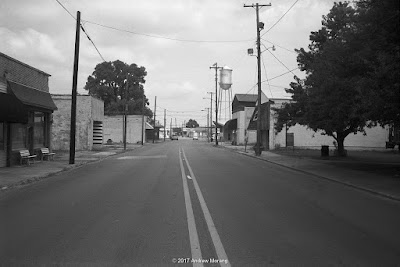 |
| Kansas City Southern railroad and Front Street, Edwards, Mississippi |
Edwards, Mississippi, is a small town just south of Interstate 20, near a bend of the Big Black River. Before World War II, the Big Black was a Federal navigation project and was dredged and kept clear of snags, but now it is no longer maintained for commercial traffic. Like many small Mississippi towns, Edwards was prosperous up through the 1970s, but has slipped into a multi-decade decline and population loss. As usual, I do not understand the causes, considering the town is on the Kansas City Southern rail line between Vicksburg and Jackson and has easy road access to I-20. It is a mystery.
 |
Walker Evans (American, 1903 - 1975) Railroad Station, Edwards, Mississippi, 1936, Gelatin silver print 19.3 x 24.2 cm (7 5/8 x 9 1/2 in.). The J. Paul Getty Museum, Los Angeles
|
This is supposed to be a picture of Edwards taken in 1936 by Walker Edwards. Was it taken from the same bridge as my photograph no. 1 above? Was there once another bridge or crossover from which Evans took this frame? Where is the church on the left? I think the 1936 photograph may be mis-labeled and show another town. But it is not Bolton nor Bovina.
Front Street parallels the KCS tracks. The city hall is there, with the police department a short distance away.
 |
| 103 Magnolia St., Edwards, MS |
 |
| 205 Magnolia St., Edwards, MS |
Magnolia Street has some gracious old houses, demonstrating former wealth in the town.
This is the former Dodge automobile dealer, at the corner where old U.S. 80 makes a sharp right-angle turn. An old-timer in town told me that Edwards was prosperous enough in the 1970s to have two car dealerships. (
Update April 21, 2018: the old car shop is being demolished)
The high school gymnasium was designed by architect James Manly Spain in the Art Moderne style. It was completed just before we entered World War II in 1941 by the National Youth Administration (from the Mississippi Department of Archives and History). I have photographed this building before, and there has been no change in status.
The water tower is a prominent feature at the corner of U.S. 80 and Main Street. I was surprised it was over a century old. The big rivets are an example of early 20th century steel and iron construction. This was solid construction, intended to last the ages.
Main Street, which runs north-south, was once, well, the main street, with stores and small companies.
Both the east and west sides of South Main have stores with collapsed roofs. (
Update April 21, 2018: this southernmost building has been demolished)
On Main Street north of the tracks, the former Woodmen of America building was in poor condition in 2008. A former coworker from the Waterways Experiment Station had bought the historic building to preserve it, but the task may have been too much for her. It is now gone. Other historic buildings on Main Street were demolished in the mid-2000s, with the bricks salvaged for use in McMansion construction (recall, this was in the last gasp of the construction orgy before the 2007-2008 housing collapse). Much of Utica's former commercial core suffered the same fate.
Drive around the streets and the scene is pretty depressing. Joe's Lounge on Utica Street is a short distance from a collapsed store. (
Update April 21, 2018: the collapsed store is gone and the lot is empty.)
On Williams Drive, a store of modern construction, also closed.
Just off I-20, the fellow who restores old cars still has interesting Detroit iron in his yard. I am not sure if all these very cars are still there because the lot looks a bit more empty now. I have not seen any Edsels recently, but there may be some in there under the kudzu.
I took the 2017 photographs with my Yashica Electro 35CC compact rangefinder camera on Ilford Delta 100 film. There was rain and drizzle, and the contrast worked out perfectly with this film and development. I bought this little Yashica as a convenient walkabout camera for an upcoming trip to Nepal. The 35mm ƒ/1.8 Color Yashinon-DX lens, a Sonnar type, is very high quality. Praus Productions in Rochester, NY developed the film.
The 2008 frame of the old Chevrolets is from Kodak Panatomic-X film, taken with a Fujifilm GW690II medium format camera.















































